
January 17th, 2023
RCLCO’s Real Estate Market Sentiment Survey has tracked confidence in U.S. real estate market conditions for over 10 years. The survey respondents span the real estate industry from operators, developers, investors, service providers, municipalities and more. In 2022, we added a new section to the mid-year survey to better understand the real estate industry’s interest in and adoption of environmental, social, and governance (ESG) initiatives within the investment process. ESG has become a prominent investment topic in recent years—and has recently experienced growing backlash from both ends of the political spectrum. Recognizing these reactions, we wanted to better understand how, if at all, it is actually influencing investment or business decisions in real estate in the U.S.
The results suggest a mixed story, and, we believe, a general lack of appreciation for why ESG became a matter of discussion in the first place. This article attempts to unpack what has become a loaded topic by going back to the original intent of the ESG movement in investing, and using our survey results to highlight how it is perceived and put into practice today. We then conclude with our view on why we think having ESG as a component of a company’s investment strategy is integral to long-term success—and how companies can get started (or restarted, as necessary).
Status of ESG Today
The concept of incorporating the principles of ESG in investing was kickstarted by a 2004 United Nations-backed landmark report sponsored by the Swiss government and endorsed by global financial institutions across several countries. The initiative encouraged the incorporation of ESG considerations into the investment process in order to reduce risk and mitigate the impacts of future regulation. Inherent within this investment advice was a recognition that 1) incorporation of ESG factors recognizes generally underappreciated risks and avoiding or mitigating these risks should result in improved returns, 2) beneficiaries are demanding investment transparency, and 3) regulations are evolving quickly at the local and national level requiring disclosure and mitigation.
By 2022, most investors across all industries, including real estate, know what ESG stands for, but in practice it has become many things: a major analysis framework, a growing professional service within companies and consultancies, and an overwhelming and expanding universe of considerations for investors. To further compound this general complexity, the term itself has become polarizing, invoking criticism from all sides, from politicians who assume that use of the term invites violation of fiduciary duty, to climate activists arguing that investor ESG pledges amount to “greenwashing” designed to avoid future regulation.
Left in the middle is the investment community—investors, investment managers, lenders, operators, consultants, etc.—which recognizes that the factors underneath the ESG umbrella certainly matter when it comes to evaluating risks and returns, but have neither consistent direction nor data to effectively assess and price risks and opportunities.
Key Takeaways From the Survey
This dislocation comes through in our survey results: what were intended to be the primary benefits inherent within the movement to incorporate ESG into the investment framework, risk mitigation and value enhancement, seem to be drowned out by other factors. In summary, we have identified five primary observations from the survey:
Capital sourcing drives adoption of ESG in the investment process
Our survey found that 38% of investment firms have an established ESG policy, with significant variation across organizations based on capital structure. Public (listed) companies and private companies investing on behalf of institutional investors were much more likely to have an ESG policy in place, at 61% and 55% respectively. In contrast, only 22% of managers that rely on high-net-worth capital have an established policy in place.
Capital Source for Companies with ESG Policy
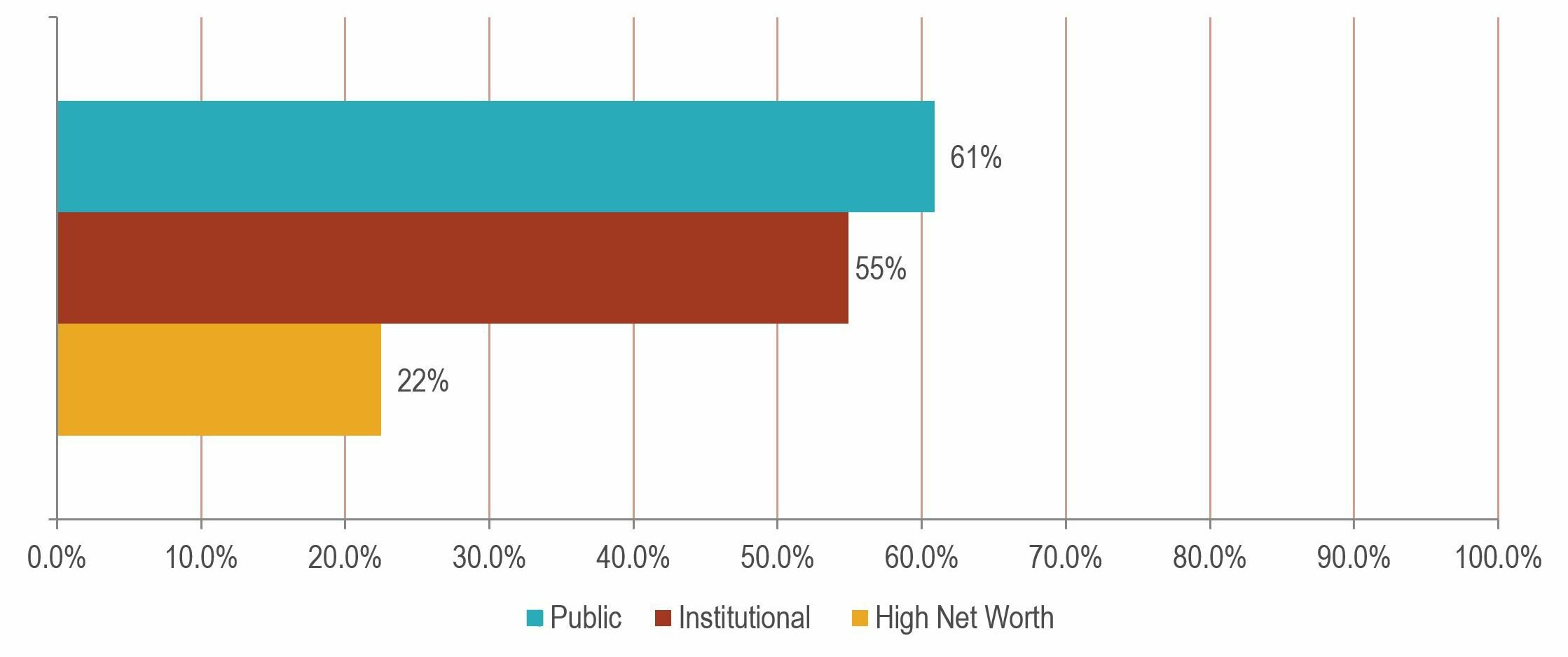
Source: RCLCO
This result suggests, in contrast to the current narrative in some circles that asset managers are pushing ESG on their investors, that the investors themselves are the driving force for ESG adoption. This theme is consistent with our experience, as well, and is likely driven by the fact that institutional investors and REITs are inherently long-term investors. According to academic research from the University of Pennsylvania, “a main driver of the move to embrace ESG in pensions is the inherent need for long-term managers of corporate risk and opportunities to live up to their responsibilities as intergenerational stewards of capital.”(1) According to Nareit, the REIT industry association, ESG topics led the list of questions by investors in 2021, with the top two topics being greenhouse gas (GHG) emissions and climate change opportunities and risk.(2)
Respondents report the importance of “values” in driving company ESG adoption…
Interestingly, for those companies with an ESG policy in place, respondents did not cite “investor demand” as the primary reason for adoption (though it did come in as the fourth most popular reason). Instead, “alignment with company values” came in as the leading factor, by a fairly wide margin, driving ESG exploration or adoption, followed by the desire to have a positive community impact.” In fact, when combining the “moderate” and “high influence” categories, “alignment with company values” was listed as a factor by 82% of respondents whose companies had an ESG policy; “positive community impact” was cited by 77%. This result is curious and leads us to wonder if companies are signaling a values-based approach to ESG because performance (risk and return) factors are more challenging to measure.
“Fiduciary duty,” “investor demand,” and “competitiveness” did rank next, likely suggesting the strong influence that both institutional and REIT investors have on real estate companies’ degree of interest in ESG adoption.
Factors Leading to ESG Exploration or Adoption
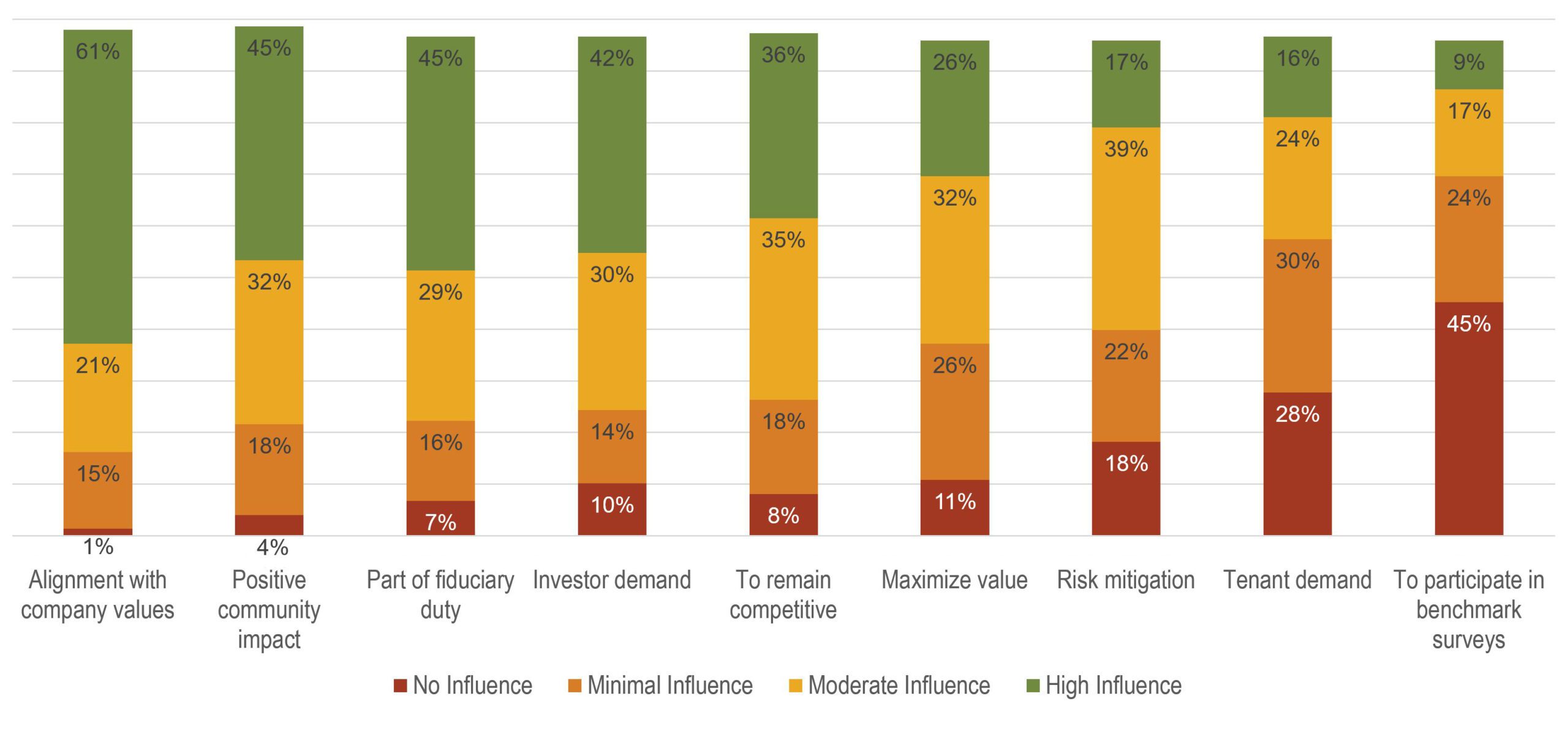
Source: RCLCO
…While underemphasizing returns and risk
One of the survey surprises was that “maximize value” and risk mitigation” came out toward the bottom of the factors leading companies to adopt ESG-related policies or practices, suggesting that many respondents may continue to perceive an inherent conflict between “doing well” and “doing good.” These two factors were the only potential responses to this question related to investment economics and returns and are, in our view, the most important reasons for paying attention to ESG through a fiduciary lens. Exploring this potential disconnect could be the primary purpose of a follow-on survey and further discussion within the real estate industry to address and respond to any perceived conflict between generating returns and taking into account ESG factors into investment decisions.
Are we approaching “peak” ESG adoption?
61% of companies surveyed do not currently have an ESG policy in place; of those, only 18% have plans to create one. We acknowledge that companies and investors without an official ESG policy can and probably do still pay attention to ESG factors in their business planning and underwriting, though this response suggests a relative lack of enthusiasm around adoption of ESG in the near future. The results are moderately different for companies backed by institutional capital, where 32% of those still without an ESG policy say they intend to adopt one.
If Not, Do You Intend to Create One In the Next 12 to 18 Months?*
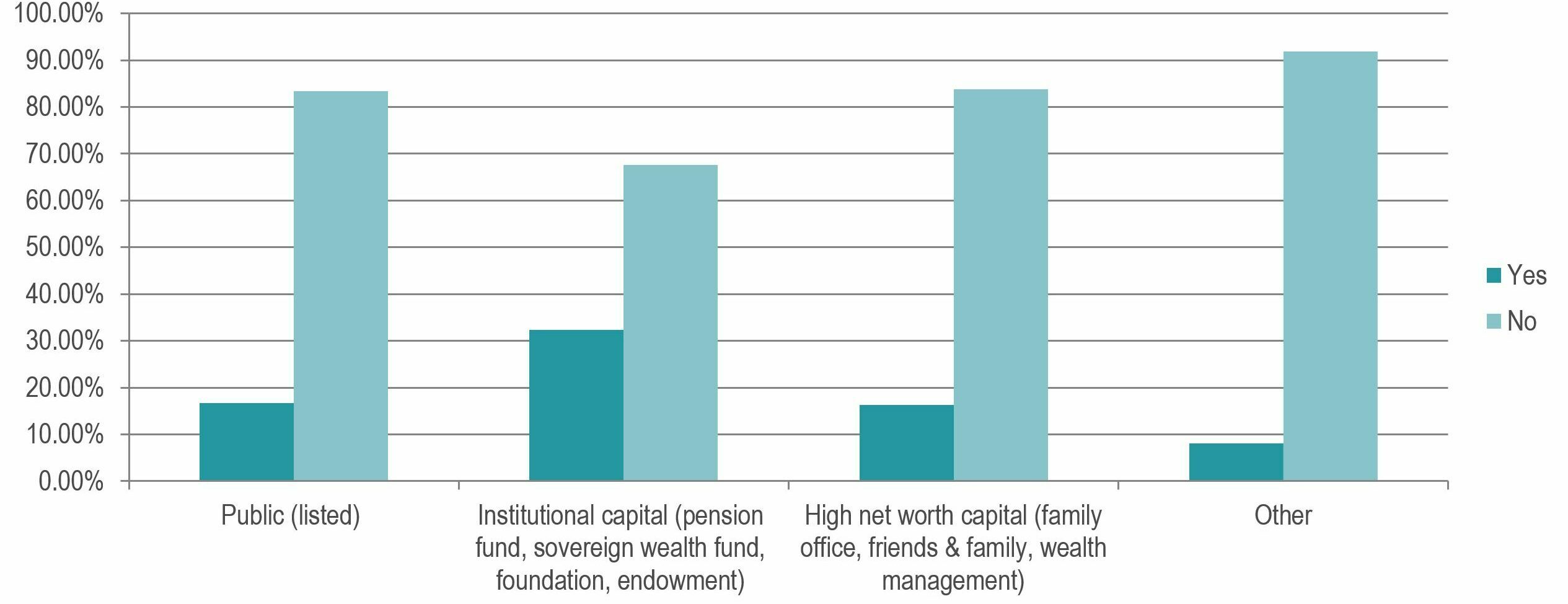
*Responses by primary sources of capital
Source: RCLCO
Alongside these findings, the survey also suggests that there are few internal or external barriers to adopting ESG policies or practices. Among companies currently without ESG policies in place, “lack of internal resources” and “management support” appeared to be the most common barriers, but even these were described as moderately or highly important by only 36% and 30% of respondents, respectively. The most common response to the question about barriers to adopting ESG policies and practices was that there really aren’t any. These results seem to indicate that for those organizations not moving forward with ESG, the largest barrier is inertia or a lack of interest in the sector.
In any event, while our survey results suggest we may be approaching “peak” ESG adoption on a voluntary basis, we believe companies may not have much of a choice regarding whether to embrace these principals or not. Irrespective of the merits associated with evaluating the long-term risks and opportunities contemplated by ESG, which we believe to be very important, additional government regulation (federal, state, local), requirements by lenders, increasing insurance costs, and demands by capital will very likely push the industry toward embracing ESG as part of the investment process.
Barriers to ESG Adoption / Exploration
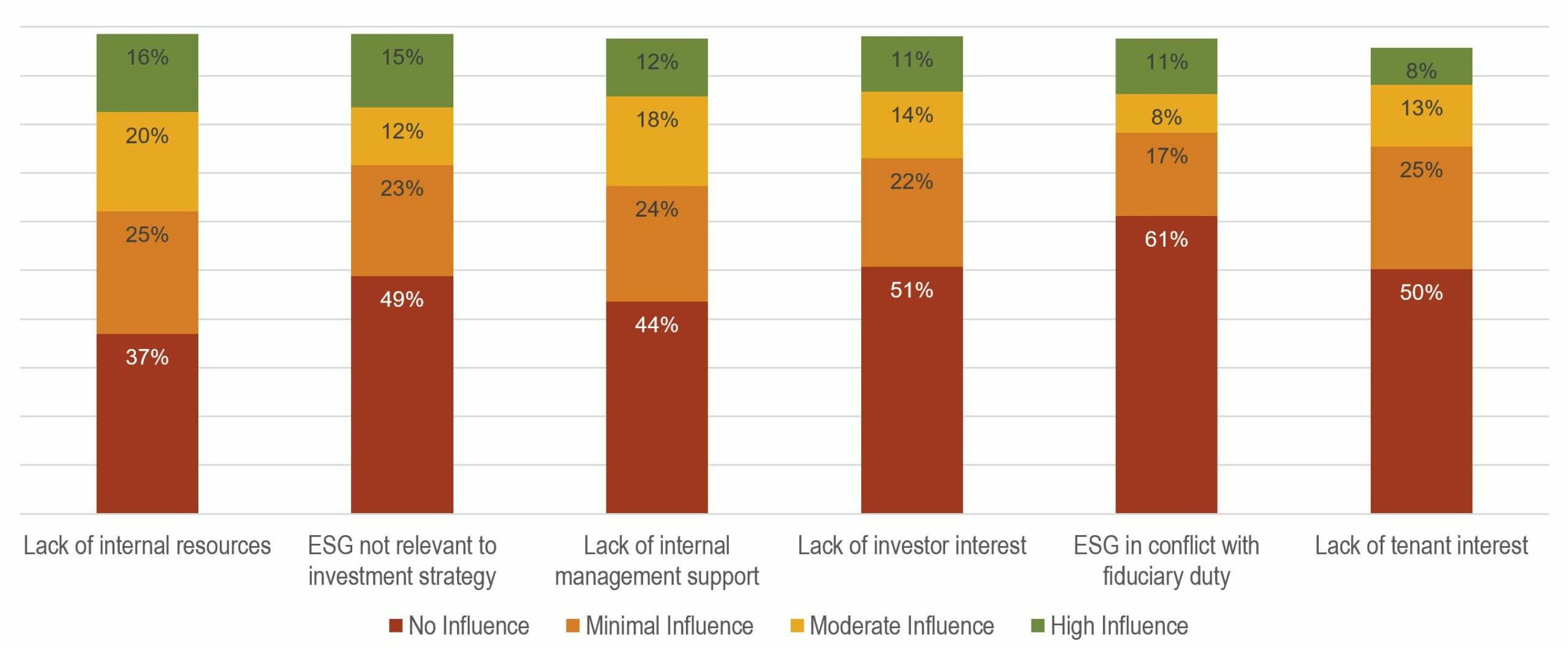
Source: RCLCO
The E is Dominant, But We’re Far Away From Net Zero
Our respondents in the real estate industry were far more likely to identify with benchmarks or frameworks related solely to environmental sustainability than they were to other, more holistic ESG frameworks. ENERGY STAR and LEED led the pack, with 67% and 63% of respondents, respectively, reporting that their companies participate in these. Relative to the five ESG frameworks that we included in the question, these have been around in the U.S. for the longest amount of time, are (relatively) straightforward to adopt, and likely have the most obvious return on investment. Regulators in the public sector have also been more actively pushing these; adoption of ENERGY STAR, in particular, has been driven in large part by energy data participation requirements at the local municipality level.
Top Five Sustainability Tools, Benchmarks, and Frameworks
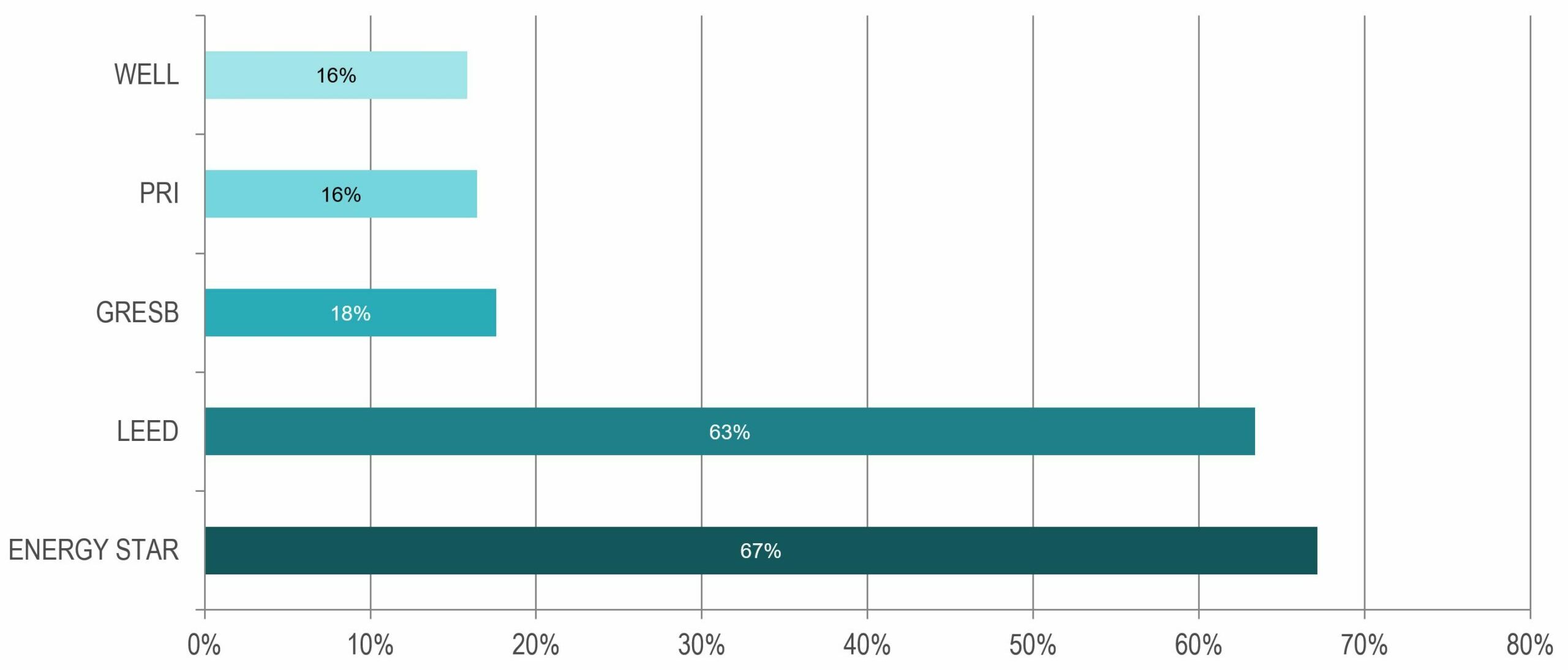
Source: RCLCO
The pinnacle of sustainability frameworks is the pledge to reach “net zero” carbon emissions within a company and/or real estate portfolio. Our survey responses suggest that this is still predominantly off the radar for the industry: 84% of total respondents do not have a net zero target, and even among those firms with an ESG policy in place, 71% have not made a net zero pledge. Of those with a pledge in place, two-thirds have set the target for 2030 or later. Nevertheless, local governments in major U.S. cities are going on the offense, enacting strict carbon emissions reduction targets (alongside associated heavy fines for noncompliance) with the goal to incentivize the real estate community to hasten the move toward net zero. It’s therefore likely we’ll see more net zero pledges announced in the future.
Net Zero Pledges (Respondents with ESG Policy In Place)
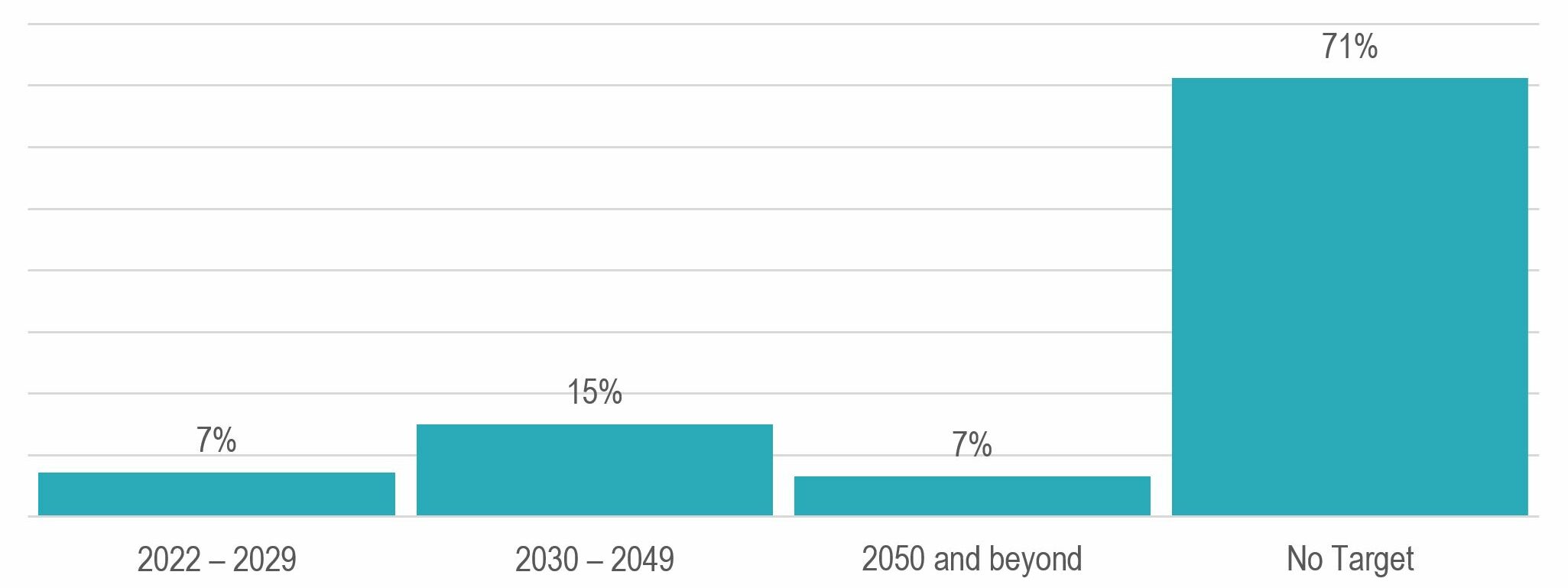
Source: RCLCO
So What? Recommendations For Those Who Would Like To Do Something About ESG (Or Gain Access To Institutional Capital)
Our survey results tell us that the intended benefits of the ESG framework—risk mitigation and value enhancement—may be underappreciated by the real estate community. Where adoption is prevalent, investors are leading the charge, and buy-in for sustainability is high. For those organizations that are not adopting ESG within the investment thesis, it is not a priority in the near term. Where does that leave those who would like to see more meaningful incorporation of the risks and opportunities associated with ESG factors, and how can real estate investors and operators make meaningful progress? Here are a few straightforward suggestions.
Start with the Simple
ESG is an overwhelmingly broad topic that has come to absorb all of the “do the right thing” initiatives under one abbreviation. Since culture and core values seem to be such an important driver, identify what is specifically important to your organization. What parts of ESG matter most to you and your colleagues? Focus your attention here. Certainly, all-encompassing considerations such as strong governance, greater diversity in the organization, and incorporation of resiliency measures at the investment level are important to all investors, but from there, companies should select from a menu of options to enhance returns. The most successful ESG strategies are closely aligned with a company’s core competencies. Then focus on a more manageable set of ESG initiatives, and do each more effectively.
Focusing on a more limited set of initiatives also has the benefit of not overloading current resources within an organization. Given that a lack of internal resources was reported as one of the primary barriers to adopting an ESG program, taking a measured approach can ease the burden on the team while building the model.
Emphasize the Economics
The most commonly cited reason we hear to deemphasize ESG factors in investment decisions is because they come into conflict with returns, and this came through implicitly in our survey, as well. We think this is in many instances a red herring, as research has developed a strong economic case for incorporating environmental and other factors into investment strategies.(3) As regulation continues to expand and assets have the potential to become stranded, unable to secure insurance or financing, integrating climate risk into investment decision making and portfolio allocation has to be part of almost any real estate investment process.(4) Identifying and then rigorously evaluating risks and opportunities to be able to demonstrate clear returns on investment is necessary to cut through any argument that suggests a focus on sustainability is counter to a fiduciary mandate.
Track the Changes
Don’t get Distracted
Reporting and benchmarks seem to dominate many conversations about ESG, both at conferences and with investors and managers. We hear from managers that the sheer volume of information and varying ways to measure performance stall well-intentioned efforts, all the while trying to please one set of investors and not offend others. We hear from investors that limited data and analysis around ESG keeps them from providing clear direction or making more progress.
It’s important to not let reporting and benchmarking get in the way of simply making progress. In building the case for a specific ESG initiative, a logical argument or clear hypothesis can be just as effective as quantitatively-derived correlations—which will likely be more feasible later as we develop the data through early activities. Both investors and investment committees want to see and understand long-term risks and opportunities, many of which are addressed within an ESG framework. The industry can take concrete action today to mitigate or take advantage of these, as long as we don’t get too distracted by the reporting and benchmarking.
Integration is Key
Finally, we might argue that we’ll only be successful in implementing an ESG framework when we stop talking about a specific set of “do the right thing” concepts, and integrate it into our businesses and investment decisions. Having dedicated ESG professionals is probably necessary today in order to educate stakeholders on the underappreciated risks and opportunities comprised under the ESG umbrella, but we will be more effective when these are simply folded into business and investment plans. Investment teams can change the narrative by moving from checking boxes (“Have a DEI policy?” “Check!”) to seamlessly incorporate the associated risks and opportunities into the standard process. Asset managers can better integrate cost-benefit analyses into potential initiatives (e.g. a potential system upgrade, finding ways to creatively finance resiliency improvements) to make these win-wins for tenants and owners.
Conclusion
ESG investing incorporates indirect financial factors into the decision-making process. This is paramount in real estate investing given the direct connection of the built environment to its surrounding community and impact on the environment. At its core, ESG can be viewed a framework to hedge investment risk and maximize returns. Our survey suggests that this is not principally how the real estate industry thinks about it, however, which is probably the cause of both the indifference (apparent in our survey) and the politicized tumult around the topic. This is likely doing a disservice to investors and the general public that relies on real estate, who need the industry to help surface and address risks and opportunities. We suspect that the ESG conversation requires a “reset” within companies and the industry. Focusing on the simple and the economics, and then avoiding distraction by integrating ESG into our basic analyses, are likely good places to start.
References
(1) https://pensionresearchcouncil.wharton.upenn.edu/wp-content/uploads/2021/04/Lachance-and-StroehleCombined_4.8.21.pdf
(2) https://www.reit.com/news/blog/market-commentary/greenhouse-gas-climate-change-top-list-investors-ask
(3) https://docs.prea.org/pub/C053062B-1866-DAAC-99FB-0F63B825441A
(4) For further research, see the recent joint ULI and LaSalle report, “How to Choose, Use, and Better Understand Climate-Risk Analytics” https://knowledge.uli.org/reports/research-reports/2022/how-to-choose-use-and-better-understand-climate-risk-analytics
Reasonable efforts have been made to ensure that the data contained in this Advisory reflect accurate and timely information, and the data is believed to be reliable and comprehensive. The Advisory is based on estimates, assumptions, and other information developed by RCLCO from its independent research effort and general knowledge of the industry. This Advisory contains opinions that represent our view of reasonable expectations at this particular time, but our opinions are not offered as predictions or assurances that particular events will occur.
Disclosures
RFA is a SEC registered investment advisor, collectively hereinafter (“RFA”). The information provided by RFA (or any portion thereof) may not be copied or distributed without RFA’s prior written approval. All statements are current as of the date written and does not constitute an offer or solicitation to any person in any jurisdiction in which such offer or solicitation is not authorized or to any person to whom it would be unlawful to make such offer or solicitation.
Research & Outlook Disclosure
This information was produced by and the opinions expressed are those of RFA as of the date of writing and are subject to change. Any research is based on RFA’s proprietary research and analysis of global markets and investing. The information and/or analysis presented have been compiled or arrived at from sources believed to be reliable; however, RFA does not make any representation as their accuracy or completeness and does not accept liability for any loss arising from the use hereof. Some internally generated information may be considered theoretical in nature and is subject to inherent limitations associated therein. There are no material changes to the conditions, objectives or investment strategies of the model portfolios for the period portrayed. Any sectors or allocations referenced may or may not be represented in portfolios of clients of RFA, and do not represent all of the securities purchased, sold or recommended for client accounts.
Due to differences in actual account allocations, account opening date, timing of cash flow in or out of the account, rebalancing frequency, and various other transaction-based or market factors, a client’s actual return may be materially different than those portrayed in the model results. The reader should not assume that any investments in sectors and markets identified or described were or will be profitable. Investing entails risks, including possible loss of principal. The use of tools cannot guarantee performance. Past performance is no guarantee of future results. The information provided may contain projections or other forward-looking statements regarding future events, targets or expectations, and is only current as of the date indicated. There is no assurance that such events or targets will be achieved, and may be significantly different than that shown here. The information presented, including statements concerning financial market trends, is based on current market conditions, which will fluctuate and may be superseded by subsequent market events or for other reasons.
Market indices are included in this report only as context reflecting general market results during the period. RFA may trade in securities or invest in other asset classes that are not represented by such market indexes and may have concentrations in a number of securities and in asset classes not included in such indexes. Accordingly, no representations are made that the performance or volatility of the model allocations will track or reflect any particular index. Market index performance calculations are gross of management and performance incentive fees.
The charts depicted within this presentation are for illustrative purposes only and are not indicative of future performance.
Copyright ©️ 2023 RCLCO. All rights reserved. RCLCO and The Best Minds in Real Estate are trademarks of Robert Charles Lesser & Co. All other company and product names may be trademarks of the respective companies with which they are associated.










